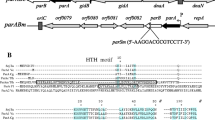Summary
A set of plasmids containing 42, 21 and 13 bp direct repeats was used to analyze the effect of repeat length on the frequencies of deletion formation and the structure of the deleted derivatives of different recombination-deficient Escherichia coli strains. Agarose gel electrophoresis of plasmid DNA demonstrated that the formation of deletions in these plasmids was associated with dimerization of plasmid DNA. Restriction analysis of the dimers showed that deletions at short direct repeats arose non-conservatively, that is, the formation of a deletion in one monomeric plasmid unit was not associated with a duplication in the other. Mutations in the recA, recF, recJ and recO genes had no marked effect on either the frequencies of deletion formation or the structure of dimers. In contrast, recB recC mutations greatly increased the frequencies of deletion formation, 6-fold for 42 bp, and 115-fold for 21 by direct repeats. Conversion of DNA replication to the rolling circle mode in a recB recC strain, resulting in the formation of double-stranded ends, is suggested as the stimulatory effector.
Similar content being viewed by others
References
Albertini AM, Hofer M, Calos MP, Miller JH (1982) On the formation of spontaneous deletions: the importance of short sequence homologies in the generation of large deletions. Cell 29:319–328
Brunier D, Michel B, Ehrlich SD (1988) Copy choise illegitimate DNA recombination. Cell 52:883–892
Chen J-H, Porter RD (1990) Mutations in the bacteriophage λ pL/ oL region that spontaneously occur in plasmid pRPZ126. Mutat Res 228:81–87
Christiansen C, Baldwin RL (1977) Catalysis of DNA reassociation by the Escherichia coli DNA binding protein. J Mol Biol 115:441–454
Cohen SN, Clark AJ (1986) Synthesis of linear plasmid multimers in Escherichia coli K-12. J Bacteriol 167:327–335
Conley EC, Saunders VA, Jackson V, Saunders JR (1986) Mechanism of intramolecular recyclization and deletion formation following transformation of Escherichia coli with linearized plasmids DNA. Nucleic Acids Res 14:8919–8932
Dianov GL, Kuzminov AV, Mazin AV, Salganik RI (1991) Mechanisms of deletion formation in Escherichia coli plasmids. I. Deletion formation mediated by long direct repeats. Mol Gen Genet
Edlund T, Nor-mark S (1981) Recombination between short DNA homologies causes tandem duplication. Nature 292:269–271
Efstratiadis A, Posakony JW, Maniatis T, Lawn RM, O'Connel C, Spritz RA, DeRiel JK, Forget BG, Weissman SM, Slightom JL, Blechl AE, Smithies O, Barelle FE, Shoulders CC, Proudfood NJ (1980) The structure and evolution of the human aglobin gene family. Cell 21:653–668
Farabaugh PJ, Schmeissner U, Hofer M, Miller JH (1978) Genetic studies of the lac repressor. VII. On the molecular nature of spontaneous hotspots in the lacI gene of Escherichia coli. J Mol Biol 126:847–857
Franklin NC (1971) Illegitimate recombination. In: Hershey AD (ed) The Bacteriophage Lambda. Cold Spring Harbor Laboratory Press, Cold Spring Harbor, New York, pp 175–194
Gilbert W, Dressler D (1968) DNA replication: the rolling circle model. Cold Spring Harbor Symp Quant Biol 33:473–484
Henikoff S (1984) Unidirectional digestion with exonuclease III creates targeted breakpoints for DNA sequencing. Gene 28:351–359
Ikeda H, Aoki K, Naito A (1982) Illegitimate recombination mediated in vitro by DNA gyrase of Escherichia coli: structure of recombinant DNA molecules. Proc Natl Acad Sci USA 79:3724–3728
Janniere L, Ehrlich SD (1987) Recombination between short repeated sequences is more frequent in plasmids than in chromosome of Bacillus subtilis. Mol Gen Genet 210:116–121
Jones IM, Primrose SB, Ehrlich SD (1982) Recombination between short direct repeats in a recA host. Mol Gen Genet 188:486–489
Mahajan SK, Padit NN, Sarkari JF (1984) Host functions in amplification/deamplification of Tn9 in Escherichia coli K-12: A new model for amplification. Cold Spring Harbor Symp Quant Biol 49:443–451
Marvo SL, King SR, Jaskunas SR (1983) Role of short regions of homology in intermolecular illegitimate recombination events. Proc Natl Acad Sci USA 80:2452–2456
Nakano MM, Ogawara T, Sekiya (1984) Recombination between short direct repeats in Streptomyces lavendulae plasmid. J Bacteriol 157:658–660
Riele H, Michel B, Ehrlich SD (1986) Are single-stranded circles intermediates in plasmid DNA replication? EMBO J 5:631–637
Salganik RI, Timchenko TV, Dianov GL (1987) Molecular mechanisms of deletions appearing as a result of double-chain break in DNA. Dokl Akad Nauk SSSR (Russian) 296:226–230
Seelke R, Kline B, Aleff R, Porter RD, Shields MS (1987) Mutations in the recD gene of Escherichia coli that raise the copy number of certain plasmids. J Bacteriol 169:4841–4844
Silberstein Z, Cohen A (1987) Synthesis of linear multimers of oriC and pBR322 derivatives in Escherichia coli K-12: Role of recombination and replication functions. J Bacteriol 169:3131–3137
Singer BS, Westley J (1988) Deletion formation in bacteriophage T4. J Mol Biol 202:233–243
Skalka A (1974) A replicator's view of recombination (and repair). In: Grell RF (ed) Mechanisms in recombination. Plenum Press, New York London, pp 421–432
Sommer H, Schumacher B, Saedler H (1981) A new type of ISImediated deletion. Mol Gen Genet 184:300–307
Taylor AF (1988) RecBCD enzyme of Escherichia coli. In: Kucherlapati R, Smith GR (eds) Genetic recombination. Am Soc Microbiol, Washington, p 231
Weston-Hofer K, Berg DE (1989) Palindromy and the location of deletion endpoints in Escherichia coli. Genetics 121:651–658
Whoriskey SK, Nghiem V-H, Leong P-M, Masson J-M, Miller JH (1987) Genetic rearrangements and gene amplification in Escherichia coli: DNA sequences at the junctures of amplified gene fusions. Genes Dev 1:227–237
Yi T-M, Stearns D, Demple B (1988) Illegitimate recombination in an Escherichia coli plasmid: modulation by DNA damage and a new bacterial gene. J Bacteriol 170:2898–2903
Author information
Authors and Affiliations
Additional information
Communicated by R. Devoret
Rights and permissions
About this article
Cite this article
Mazin, A.V., Kuzminov, A.V., Dianov, G.L. et al. Mechanisms of deletion formation in Escherichin coli plasmids. Molec. Gen. Genet. 228, 209–214 (1991). https://doi.org/10.1007/BF00282467
Received:
Issue Date:
DOI: https://doi.org/10.1007/BF00282467




